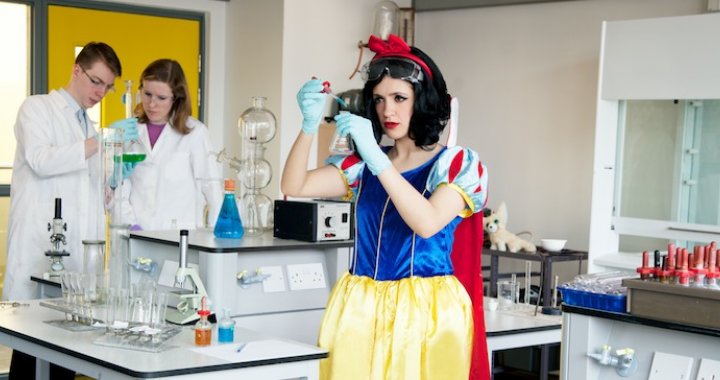
Using Humour as a Trojan Horse
11/02/2013
British artist Sarah Maple (1985) first brought the art world’s attention towards herself, when in 2007 she won the “4 New Sensations” competition for emerging artists, run by Charles Saatchi. But a year later her first solo exhibition “This Artist Blows” made headlines by openly exploring the themes of sexuality, culture and religion from the viewpoint of a British-Muslim woman. Not only did the exposition get vandalised, but also the artist received death threats. Since then Sarah Maple has slowly retired from investigating this controversial subject and is now more interested in verifying that being a feminist can also be amusing.
Sarah Maple’s newest exhibition has taken her to Tallinn, where Arterritory.com met Sarah and talked to her about what it means to be a feminist with a sense of humour. The artist’s solo exhibition is open for viewing through February 24, 2013, at Tallinn City Gallery, Estonia.
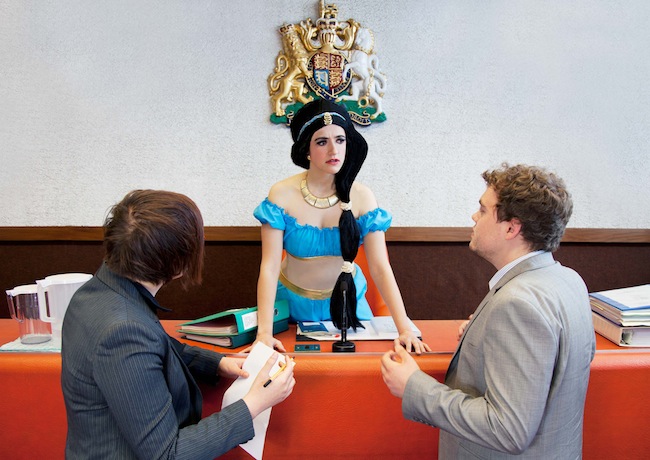
Judge Jasmine. 2011. Lightbox. 85 x 55 x 12 cm
You once expressed that art gives you the opportunity to explore the sorts of things you wouldn’t explore in your actual life, that you use art as an outlet – especially with sexuality. Could you elaborate on that?
Art gives me a voice. It’s a way of getting things out of the door; saying and doing things that I wouldn’t usually be able to express. It’s also about having different personas. It sometimes feels like I’m doing things behind a mask.
Does this mean that you are shy?
I think so… maybe …. possibly. When people look at my work, they expect me to be different to what I am like. They expect me to be quite a loud person, but I am more reserved than that.
People have sometimes compared you to Tracey Emin. How do you want to be perceived as an artist?
I want to be perceived as me, as my own person. I guess comparisons are always going to be made, because people want to put you in a box next to other people. They want to figure out what kind of artist you are. I just want to do my own thing. At the moment it’s mainly feminist art and women’s issues.
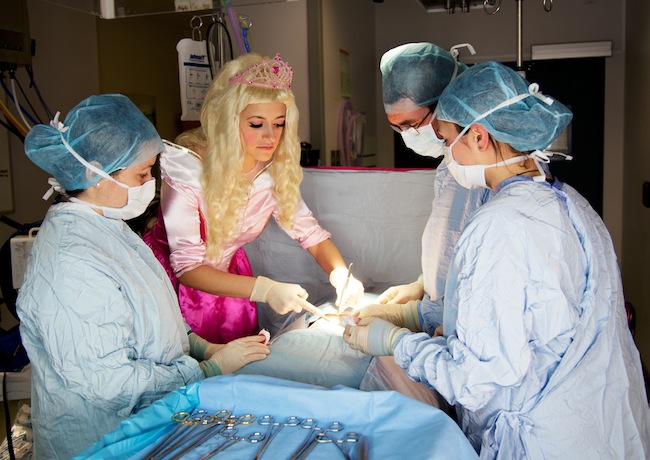
Sleeping Beauty performs an operation. 2011. Lightbox. 85 x 55 x 12 cm
What does feminism mean to you?
For me it’s equality. There are so many ways of viewing it. A lot of people have a negative perception of what it is. It can be seen in different ways. You can especially see that at feminist conferences, where women are always arguing with each other about what it actually is. For me it is equality and I try to put this idea into my works the best way I can.
In 2010 you curated an art auction “Feminism in London”. Could you tell me more about that?
I asked a lot of artists, musicians and creative people to create a postcard relating to feminism. Many interesting people, mostly from the UK and London, responded to that. It got a good media reaction as it also involved some well-known artists, such as Julian Opie and Kate Nash. It went really well. Of course there were a few interesting reactions from some of the female celebrities saying that this was not something that they associate themselves with. It’s hard to get people involved into something that is related to feminism. People don’t really want to associate themselves with it. It was quite difficult, but I was very pleased with how it went. I did it almost singlehandedly. I don’t think I realised how much work it’s going to be.
I am also planning to do something similar in the near future. At the moment I am collaborating with a theatre person and a musician so we are going to do three different events to raise money for the next feminism conference. We are also trying to make it a bit more creative. Obviously there are perceptions about feminism so we want to do something that would be a bit more fun and that would involve people who maybe wouldn’t class themselves as feminists. Some women completely reject the term “feminism”, but at the same time they live lives that I would consider to be feminist.

Belle the football manager. 2011. Lightbox. 85 x 55 x 12 cm
What would you class as a “feminist life”?
Feeling empowered and doing the job you want to do. My sister is a surgeon and she has to deal with sexism every day in her job. You just have to stand your ground and I think a lot of women are doing that. When I first started working with this feminist theme, I was actually opposed to feminism. If anyone asked me if I were a feminist, I would have said, no. I suppose it’s not really important how you define it, as long as there is equality in the world.
I know that in recent works you have been moving away from the Islamic motives, but is it important for the audience to know that you come from a Muslim background?
I would say it is important to know regarding my Islamic work. It has also made me who I am so, in a way, it is important regarding other works as well. I don’t think you have to know, but it’s interesting to know. A lot of people have that “oh” moment, when they realise my background.
What does religion mean to you?
I think it’s about faith. People usually ask me, if I am a practicing Muslim, but I see it more as a faith. I went to a catholic school and a lot of my friends are religious, but for me – it is faith.
Some of your works have triggered a lot of emotions.
I don’t want to attack people, but I want to challenge them. I like the work “Menstruate with pride”, because you are laughing at the shocked people in the painting more than at the woman in the middle. People might think “Oh, God! How embarrassing!”, but you don’t really feel like that for the woman. I don’t think so. You are laughing at the reaction and why people are being that way.

Haram. 2008. Oil and acrylic on canvas. 175 x 125 cm
How did you arrive at the comedy side of art?
It just feels really natural for me. I like making funny things and I like making people laugh. For me humour is a Trojan horse. It’s a way of getting across things that you want to say. If something is funny, you remember it. I want people to remember my work and to think about it, but to also to really enjoy it as well. “It’s a Girl” show [which took place February 2012 in London] was divided into different rooms and if you were in one of them, you could hear people laughing in another one. It was really great to hear laughter in the gallery.
Humour is one part of what I do. Of course, it’s not just about making people laugh. There would be no point in that. My artworks are filled with all sorts of meanings and ideas, but the humour is a way of getting that across. It is a tool. It’s a way of expressing my ideas.
Do people respond differently to your works in the different places they have been displayed?
I think people get the humour side. Obviously it’s quite a British humour, but I think they understand it. I have never showed them in a country, where people wouldn’t understand them. Maybe I just haven’t done that yet. There is always a reaction to it. A lot of the themes are universal so people respond to them.
How did you decide to portray yourself in these works, to put yourself in the centre of attention?
When I was younger I used to draw portraits and I would draw myself. It started when I was quite young, but it’s hard to pinpoint why I did it. I think for me it was a way of expressing myself. It grew from there. It’s a way of putting across a point and I think I am the best person to do that in these pictures. I could try and employ a model, but it would be completely different. It wouldn’t be the same as me. I guess I am using myself as a symbol.
Don’t you feel exposed, when doing that?
Not really. People sometimes ask me if I find it weird that people have a picture of me on their wall? I don’t want to psychoanalyse it, but it doesn’t feel like me in those paintings. I don’t think of it. To me it’s just a piece of art; it’s not a personal picture of me. If a face in the artwork feels too much like mine, I won’t use it. I usually paint a pose or something else so that it doesn’t feel like me. For me it is a piece of art.
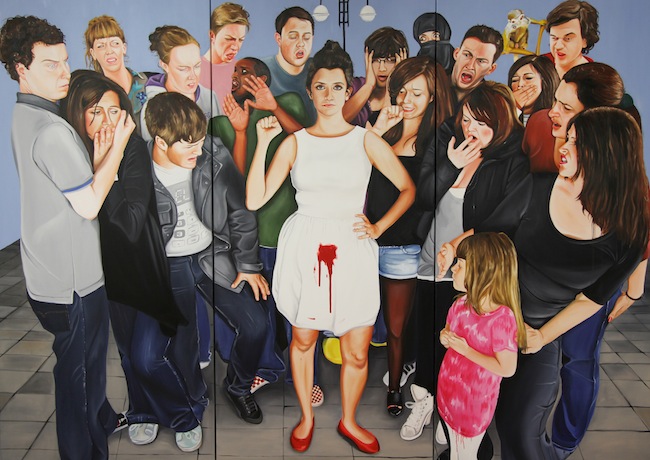
Menstruate with pride. 2010 - 2011. Oil on canvas. 215 x 275 cm
The media has called you a self-publicist. Are we now in an era where artists can achieve it all by themselves?
When I first started making my work, I wanted to show it. I had a MySpace page and I had all my works exhibited on there. I wrote to magazines asking them to look at them. I was quite brazen. I didn’t care. I just wanted to get my work out there as I had no one else to do it for me. I wanted to be seen. So after a while I started to have a positive reaction from it. It helped me to get my foot in the door. Good things came around for me just by going for that. You cannot expect people to come to you. You have to be out there telling everyone “Look at me!” (Laughs) That’s what I did. But I’m not doing that anymore.
I read your manifest or advice for artists regarding their relationship with galleries and dealers. Do you still agree with what you wrote back then?
(Laughs) Do you mean the list of “do” and “don’t”? I was very angry when I wrote that. (Laughs) It was meant to be funny as well. It was meant to be a joke. Some people did get it, but others – not so much. There were even comments saying that I was bitter and twisted. I was annoyed, because I was trying to be funny. I think I advised artists to assume that everyone is a bastard. Of course, there are a lot of bad people, but not everyone is like that. When I wrote that I had had a bad experience, but since then I have met some really genuine people, who just want to show my work. Since then I have worked with some amazing people. Maybe it’s because now I am more careful. I wasn’t always cautious regarding my business. That is an important side of the art world. I think to a degree I was right. (Laughs)
So does a young artist need an art gallery to get a career lift?
I never had one and I am not represented by one now. So I would say – not necessarily. If you have a bit of a business mind and you can take care of what you are doing, you should be fine. I suppose I am in a different position to a lot of artists, because I won the prize [“4 New Sensations” competition offered by Channel 4 and Saatchi Gallery in 2007] and did a lot of other incredible things as a result of that. It gave that “extra thing”. It also helped when getting in contact with the galleries and getting people interested in my work. I don’t think you have to have a gallery, but it does help. If you don’t want to work with an art gallery, you have to stand a large workload. I do everything myself and it can be hard.
Do you feel labelled as “the artist who won Saatchi’s competition”?
Not really. A while ago people used to mention Saatchi’s name all the time in context with my work, but now they have forgotten about it and it comes up much later. At the opening of this exhibition I almost forgot to mention it, because it happened a while ago. A lot of people don’t even realise that I have accomplished that. I don’t see it as a bad thing. I the UK there is such a cloud associated with Saatchi’s name. So it can only be good.
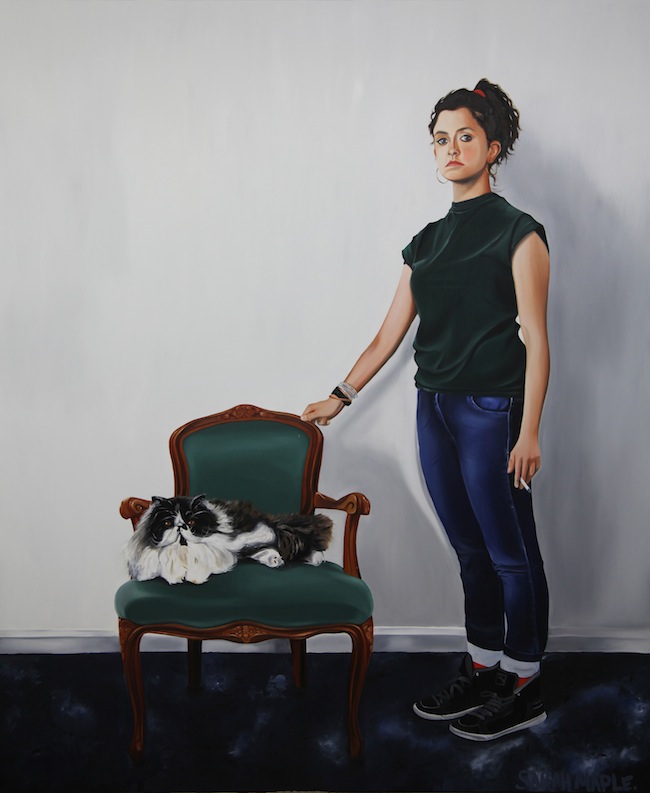
Self portrait with cat and grandparents. 2011. Oil on canvas. 214 x 178 cm
How did you become interested in art?
My mum is really good at drawing. When I was younger I also realised that I could draw. Initially it was just an interest in drawing and painting and it grew from there. I have built myself up for this since I was young. I have always wanted to be an artist. It just felt natural. Now, when I am older, I realise the power of art.
Do you have a plan as an artist of where you want to be heading?
I would like to continue working and just improving what I do, making each show better than the last, building on the themes and just being the best artist that I can be. I love making the works, so I would like to be making more stuff and trying to survive as an artist. I would love it, if for the next 20 years I could continue doing this.
What do you think is the purpose of art?
To inspire people. To change things. To comment on the world. I like seeing a lot of soul in an artwork as then you can really feel something from it. That’s what I like.
All the things that you just said seem very generous. Isn’t art sometimes selfish as well?
Yes. Sometimes, when I look at an artwork, I become annoyed, if I feel that it’s too self-indulgent. It annoyed me that, when I went to Glastonbury festival and saw Radiohead perform, they didn’t perform any of the songs people knew. They only performed their new album. It made me really angry, because no one had heard of them. At that moment I thought “you are just playing what you want to play; you don’t care about the crowd”. (Laughs) It made me think about art. I don’t know why. I always think about the audience. Obviously I can’t control what they think, but I always think of how I can talk to them and how we can communicate. That’s my primary goal.
Are the exhibitions usually perceived the way you intend them to be perceived?
I would say that there is a mixture of reactions. Everyone is different. You can’t make everyone look at things the way you want them to. People will say things and comment on things that you hadn’t even consciously considered. People will read in an artwork, what they want to read. There is only so much you can influence. You can only do your best. I used to obsess about it, but not any more. You can’t do that.
What new projects are you currently working on?
At the moment I really want to concentrate on the next body of work. All the work in this show was made at least a year ago. I look forward to doing something else. I have no idea what it is going to be about, but I would like to do some performance art. I really like performance and video art so it will probably have to do something with that. We’ll see where it takes me. I haven’t really done live performances and I don’t know if I will be up for it. Standing in front of the crowd can be scary.